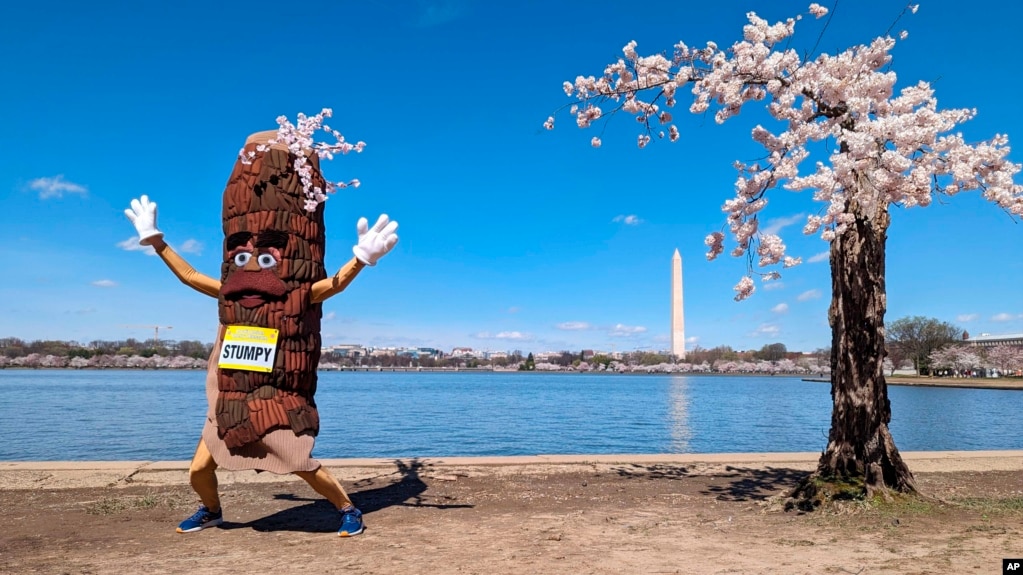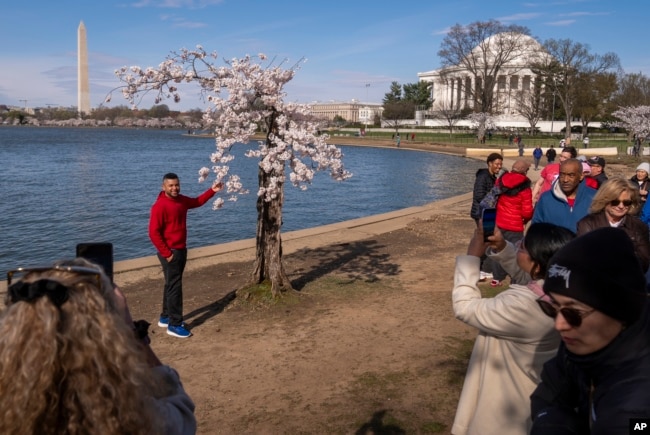Cherry Trees to Be Removed in Washington Improvement Project

Washington D.C. officials say some of the city’s famous cherry trees will need to be cut down as part of a major improvement project.
Up to 1.5 million people are expected to visit America’s capital in the early spring to attend the city's National Cherry Blossom Festival. The event celebrates Japan’s 1912 gift to the city of about 3,000 cherry trees.
During the festival, blossoms on the cherry trees are in full bloom. The main part of the festival takes place around Washington’s Tidal Basin, the area near the Jefferson Memorial that has many cherry trees.
But the Tidal Basin – which is connected to the nearby Potomac River – is in need of repairs. Currently, when water levels rise, flooding puts some trees under several centimeters of water. The improvement work will aim to build up and improve an old seawall meant to hold back the floodwaters.

The Jefferson Memorial is visible as visitors to the Tidal Basin walk along an area as cherry trees enter peak bloom this week in Washington. Wednesday, March 20, 2024. (AP Photo/Pablo Martinez Monsvais)
The U.S. National Park Service oversees the Tidal Basin, as well as the large green area of downtown Washington D.C. known as the National Mall. Officials say about 300 trees – including nearly 160 cherry trees – will be cut down during the work. After the improvements, about 300 trees will be planted as replacements.
Mike Litterst is a spokesman for the National Park Service. He told The Associated Press (AP) the $133 million project is expected to take about three years. “It’s certainly going to benefit the visitor experience, and that’s very important to us," Litterst said.
But he added that most of all, it would “benefit the cherry trees, who right now are every day, twice a day, seeing their roots inundated with the brackish water of the Tidal Basin.”
Litterst said the removed trees will be ground up and mixed with nutrient rich soil to be used to protect the roots of surviving trees. This way, the effort can be seen as providing “a good second life” for the trees being cut down, he added.

The Jefferson Memorial is visible as visitors to the Tidal Basin walk along an area as cherry trees enter peak bloom this week in Washington. Wednesday, March 20, 2024, in Washington. (AP Photo/Pablo Martinez Monsvais)
One of the trees set to be removed from around the Tidal Basin received so much attention in 2020 that it became a social media star. The tree, nicknamed Stumpy, is short and oddly shaped compared to others in the area.
At the height of the COVID-19 pandemic, Stumpy’s popularity led to the sale of many tree-related materials. The tree was also a common spot for visitors to take “selfies” while standing next to Stumpy.
Officials said the U.S. National Arboretum came up with a way to save the memory of Stumpy. Scientists plan to capture genetic material and use it to create new copies, or clones, of the famous tree.

The Washington Monument and Jefferson Memorial are visible as visitors photograph a cherry tree affectionally nicknamed 'Stumpy' as cherry trees enter peak bloom this week in Washington, Tuesday, March 19, 2024. (AP Photo/Andrew Harnik)
Organizers of the yearly event said that because of changing climate, the festival’s “peak bloom” is beginning earlier and earlier. The peak period describes when at least 70 percent of the city’s 3,700 cherry trees will be flowering.
This year, peak bloom was expected to happen on March 23, the AP reports. But the official start of the event ended up being declared on March 17.
By comparison, 2013’s peak bloom began on April 9. Leslie Frattaroli is national resources program manager for the Park Service. She told the AP in February that peak bloom could regularly come in the middle of March by 2050.
_____________________________________________
Words in This Story
bloom – v. when a flower fully opens
benefit – v. to be helped by something
inundate – v. to receive a large amount of something; to be covered with water
peak – n. the highest level or value of something
https://learningenglish.voanews.com/a/7541904.html